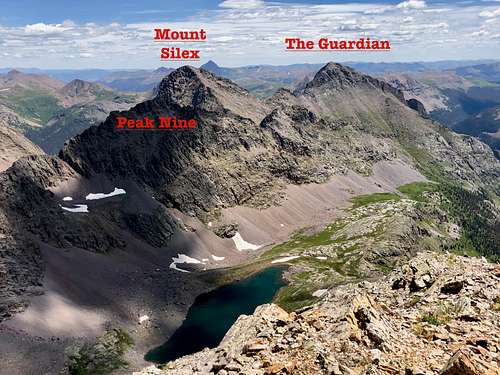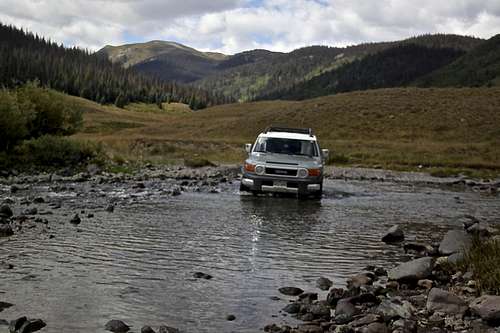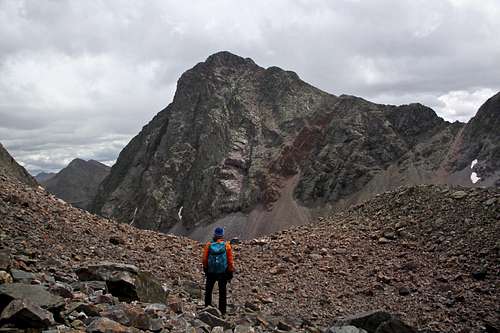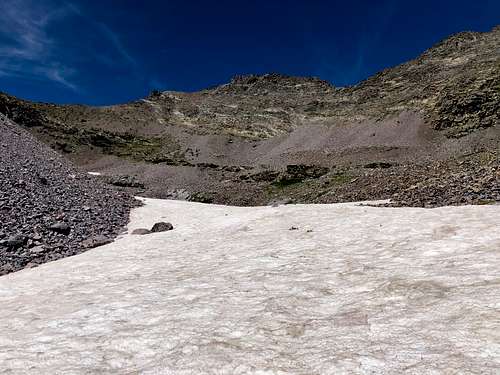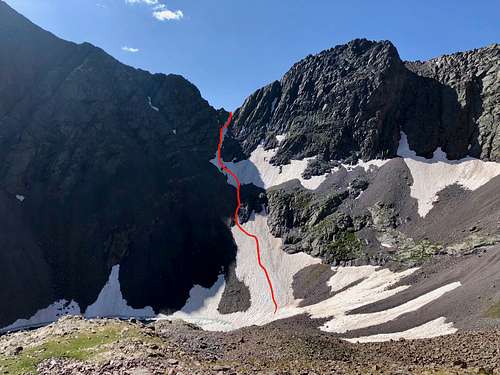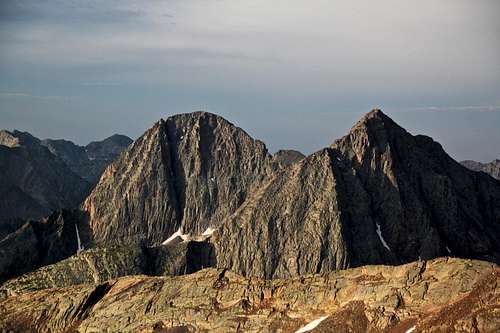-
 9618 Hits
9618 Hits
-
 81.18% Score
81.18% Score
-
 13 Votes
13 Votes
|
|
Mountain/Rock |
|---|---|
|
|
37.67020°N / 107.54812°W |
|
|
San Juan |
|
|
Hiking, Scrambling |
|
|
Summer, Fall |
|
|
13628 ft / 4154 m |
|
|
Overview
Mount Silex is a beautiful and impressive 13er, bicentennial peak located in the remote Weminuche Wilderness. The area is surrounded by a multitude of beautiful ragged peaks.The peak is often combined with another impressive looking peak The Guardian. I chose a combination of 3 bicentennial peaks Peak Seven, Mount Silex and The Guardian as a long trip from the trailhead for Hunchback Pass, but backpacking would be a better option since the approach is long.
Guide to Colorado Mountain with Robert Ormes only briefly mentions Mount Silex: "The standard climb up Mount Silex is up talus slopes on the south side, for which you need to reach the 12,800' on its southwest ridge. Drop a few hundred feet off the pass before traversing out onto the south face. Better yet, bring a rope and try the steep fourth class, southwest ridge itself. Stay to the right of major obstacles." I thought the 4th class was easy and rope was not necessary.
What does Silex mean? Per the dictionary, silex means silica, especially quartz or flint.
Colorado Rank: 181
Quad: Storm King Peak
Parent Lineage: Storm King Peak
Wilderness: Weminuche
Class: 2 loose by its easiest route, the northwest ridge has a few class 4 moves
Nearby Peaks:
- The Guardian 0.63 miles
- Peak Nine 0.66 miles
- Storm King Peak 0.76 miles
- Peak Eight 1.03 miles
- Peak Seven 1.41 miles
- Vallecito Mountain 1.71 miles
- East Trinity 1.86 miles
- Leviathan Peak 1.89 miles
- Peak One 1.95 miles
- Trinity Peak 2.08 miles
- Peak Six 2.15 miles
- Mt. Nebo 2.21 miles
- White Dome 2.34 miles
- Peak Three 2.41 miles
- West Trinity 2.47 miles
- Hunchback Mnt. 2.59 miles
- Jagged Mnt. 2.60 miles
Getting There
Route
There are many routes to reach a summit. I will describe the one recommended the Guide to Colorado Mountains and the one I took. I chose to ascend on the 4th class SW ridge, which actually was fun and that hard. The route from Silex Lake on the northwest side of Mount Silex is another popular approach, shorter if coming from Hunchback Pass, but the couloir was interrupted with steep and loose scree in the middle and I had no ice axe and only soft hiking shoes. It may be fun earlier in the season when the snow climb is continuous and ice axe and crampons are a requirement. Per other climbers reports the couloir is about 40 to 45 degrees steep.
The map below shows my entire route, combination with Peak Seven and The Guardian. The approach via Stormy Gulch (along Trinity Creek) was easier than I remembered from the previous trip to Storm King Peak. I found a decent trail on the north side of Trinity Creek and gained the meadow below Mount Silex and Storm King Peak relatively quickly. There is a steep section of the slope to gain Lake Silex. The northern side is mostly grass and easy to ascend, higher up it is rocky. Lake Silex is surrounded by rocks, not a great place to camp. The route above Lake Silex - NW couloir was not in a shape and I did not have the proper equipment (no ice axe or boots, not crampons) since I did not expect late August to have the snow there. I continued to bypass Peaks Nine and Eight and headed for Storm King Peak and Peak Nine saddle. The route here is hopping on boulders. The descent from the saddle was easy with a faint trail. I headed SW towards Peak Eight - Peak Seven saddle, climbed up the north ridge of Peak Seven, descended the same way. Passed on the north side of a little unnamed lake and headed for the next, larger unnamed lake below Peak Nine (no time for Peak Nine on this trip, but the route would start here). Bypassed along Peak Nine and had to drop lower to gain a drainage between Mount Silex and The Guardian. Mount Silex was hidden for a while behind Peak Nine. The route up the Mount Silex went fast, most of the first section was covered with snow, which was not steep and I could ascend it in my hiking shoes (no spikes or crampons). Higher up I tried to gain the SW ridge and with a few short sections of 4th class moves gained the summit. The views are spectacular, especially King Storm appears very majestic. The summit had a small cairn and I left a glass register.
Traverse to The Guardian: I did descend about 200 feet and was hoping to see some cairns, signs of travel, and not to lose too much elevation. But there were NO cairn and signs of people traveling here. I ended up on some sloping ledges with loose rock and slowly traversed towards Mt. Silex - The Guardian saddle. Walking was slow, but never too hard. It was exposed, but always some other ledge showed up and moves never exceeded 2+, possibly a few class 3 moves. When I reached the saddle, there is a small hump, which I chose to bypass on the south side and headed for the east end of The Guardian. The slopes became easier here and less loose (see the Guardian for continuation).
Red Tape
When to Climb
Camping
There is a plentitude of backpacking and camping in the wilderness. Nice campsites are along Vallecito Creek, in Stormy Gulch along Trinity Creek, along the unnamed lake just below Peak Seven, Balsam Lake on the west side of Peak Seven, or along Leviathan Creek below Mount Silex and The Guardian.
There is also camping at the Hunchback Pass Trailhead and along the Beartown road on your drive in.
External Links
- Mount Silex on List of John
- Mount Silex on 13ers.com
- Mt. Silex on Climb13ers.com
- Technical ascent of Mt. Silex on Mountain Project
- Mt. Silex on Peakbagger
- Weminuche Wilderness



